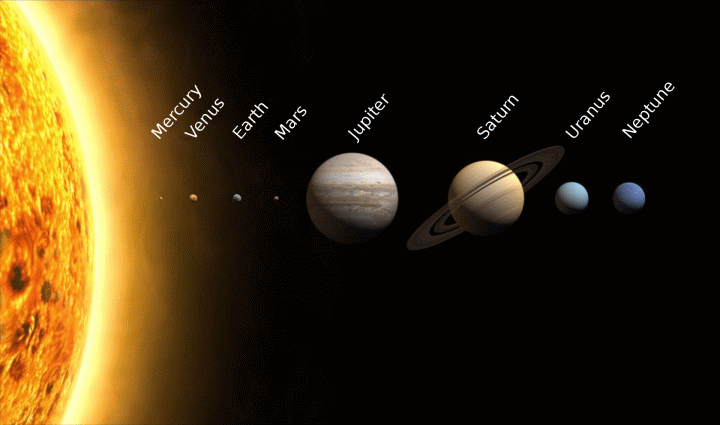Typical images of the solar system are NOT to scale, showing the planets at grossly exaggerated sizes. Here is a typical case, HT Wikimedia, WP and Planet User:

So, some video makers did a little project to show it to scale, out to Neptune . . . beyond, lies vastly more of course, but Pluto has been demoted to “dwarf planet.”
A Pandemic Sunday reflection from scripture comes to mind:
Psalm 19:1The heavens declare the glory of God; and the firmament sheweth his handywork.
2 Day unto day uttereth speech, and night unto night sheweth knowledge.
3 There is no speech nor language, where their voice is not heard.4 Their line is gone out through all the earth, and their words to the end of the world. In them hath he set a tabernacle for the sun,
5 Which is as a bridegroom coming out of his chamber, and rejoiceth as a strong man to run a race.
6 His going forth is from the end of the heaven, and his circuit unto the ends of it: and there is nothing hid from the heat thereof.7 The law of the Lord is perfect, converting the soul: the testimony of the Lord is sure, making wise the simple.
8 The statutes of the Lord are right, rejoicing the heart: the commandment of the Lord is pure, enlightening the eyes.
9 The fear of the Lord is clean, enduring for ever: the judgments of the Lord are true and righteous altogether.10 More to be desired are they than gold, yea, than much fine gold: sweeter also than honey and the honeycomb.
11 Moreover by them is thy servant warned: and in keeping of them there is great reward.12 Who can understand his errors? cleanse thou me from secret faults.
13 Keep back thy servant also from presumptuous sins; let them not have dominion over me: then shall I be upright, and I shall be innocent from the great transgression.14 Let the words of my mouth, and the meditation of my heart, be acceptable in thy sight, O Lord, my strength, and my redeemer.[KJV]
Food for thought. END
PS: Of course, someone will be bound to take up the talking point that the vastness of the cosmos points to the insignificance of man, typically tied to the Copernican demotion from the centre of the cosmos. Such is triply wrong. For one, as Ptolemy and others put it, in his geocentric model, the scale of the earth — calculated since Eratosthenes — as a ratio to the sphere of the fixed stars is as a mathematical point. Taken literally, infinity; it probably was figurative but shows that immensity was understood 2,000+ years ago. Second, Copernicus PROMOTED us from the sump of the cosmos to the heavens, alongside the other moving stars. Third, as Psalm 19 reminds, the true centre is the Creator God, whose heavens declare his glory and whose creature, man, reflects his image and should seek enlightenment of the heart from his Source and Sustainer.